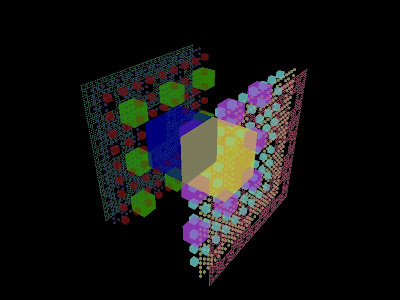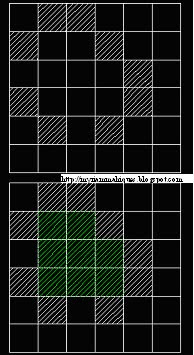Sierpinsky fractal en 3D, by Johnny Layne. From www.graynod.org/johnny/screenshots.html
The fractal dimension of cities in 2D will be always a value between zero and two. If we calculate the fractal dimension of Buenos Aires, we will see that its value does not differ - at least significantly - of the values reached in other cities. For example, at the neighborhood scale, La Boca (Buenos Aires) is in the range of D=1.80, the same is for East Los Angeles in California. Considering that they are two very different cities, this reduccionist analysis would not be enough to understand the morphological patterns of the city.
One of the important aspects is the constitution of the city in layers. And this time I do not refer to socio-cultural questions, but material constructions in layers.
In this regard, I recall a comment from the architect-archaeologist Dr. Daniel Schavelzon, who, on the Mayan cities, said "........ of NONE historical (excavated) city we have the real floor plan, it is not even possible with the techniques and methods of archeology itself, to have a floor plan of a particular moment in time ....... But our culture works on destruction-construction, which never existed before, it was physical overlay architectures. One above the other, with the abandonment, the contemporary stages between each building were destroyed. Yes, it is complex ,........."
What is the objective to reach in our spatial scale of analysis? Isn't it that cities exist in layers like Jericho and Troya, a city, superimposed to other, and other.....? In the comparison of cities, this issue will be of supreme importance.
Returning to the case of Buenos Aires-Los Angeles, the second, for being located in a seismic region, lack the multiple undergrounds and mysterious tunnels of Downtown Buenos Aires. This outline is to understand that the question does not finish here.
Buenos Aires also has aerial cables and signs that make very different the pedestrian's perception. Los Angeles appears like a city visually ¨cleaner¨. Therefore, depending on the scale selected, these visual elements should be kept in mind.
Two different layers, both graphics are ready for the fractal D calculation. By M. Mahiques
Visualization in 3D of the concepts discussed here. Picture: Internet download.
There is a methodology, for the physicists, and it is the analysis by means of ¨fractal cheeses¨, called this way because of their complex three-dimensional morphology, similar to gruyere cheeses of fractal dimension D between 2 and 3, being 3 the value of the solid cube. These graphs bear extremely complex and unreachable formulas for architects. It is for this reason that I propose humble fractal and lacunarities mensurations in 2D, but in different levels. And the comparative analysis will be simpler, we can draw graphics in 3D but these will be the expression of the results of the layers. Should we wonder then, do we study buildings or a summation of buildings in the space-time? in which period do we produce the temporary cut to carry out the analysis, if everything is constantly transforming? Do we have to be satisfied with contemplation and reach conclusions from the mere observation?




No comments:
Post a Comment